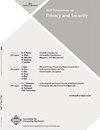ThermoSecure:研究人工智能驱动的热攻击对常用计算机键盘的有效性
IF 2.8
4区 计算机科学
Q2 COMPUTER SCIENCE, INFORMATION SYSTEMS
引用次数: 5
摘要
热像仪可以显示用户界面上的热迹,比如键盘。这可以被恶意利用来推断敏感输入,比如密码。虽然以前的工作考虑了依赖于简单图像处理技术的视觉检测的热攻击,但我们表明攻击者可以执行更有效的人工智能(AI)驱动的攻击。我们通过介绍ThermoSecure的发展及其在两个用户研究(N = 21, N = 16)中的评估来证明这一点,这揭示了关于热攻击的新见解。我们详细介绍了ThermoSecure的实现,并制作了一个由1500个键盘热图像组成的数据集,这些图像带有输入产生的热迹。我们的第一项研究表明,ThermoSecure成功攻击了6个符号、8个符号、12个符号和16个符号的密码,平均准确率分别为92%、80%、71%和55%,在30秒内拍摄热图像时准确率更高。我们发现,打字行为对热攻击的脆弱性有显著影响:快速打字者比快速打字者更容易受到攻击(热攻击成功率为92%对83%)。分别(如果在30秒内执行)。第二项研究表明,键帽材料对热攻击的有效性有统计学上显著的影响:ABS键帽在更长的时间内保留了用户按下的热痕迹,使它们更容易受到热攻击,平均攻击精度为52%,而PBT键帽键盘的平均攻击精度为14%。最后,我们讨论了系统如何利用我们的结果来保护免受热攻击,并根据我们的结果和以前的工作提出了7种缓解方法。本文章由计算机程序翻译,如有差异,请以英文原文为准。
ThermoSecure: Investigating the Effectiveness of AI-Driven Thermal Attacks on Commonly Used Computer Keyboards
Thermal cameras can reveal heat traces on user interfaces, such as keyboards. This can be exploited maliciously to infer sensitive input, such as passwords. While previous work considered thermal attacks that rely on visual inspection of simple image processing techniques, we show that attackers can perform more effective artificial intelligence (AI)–driven attacks. We demonstrate this by presenting the development of ThermoSecure and its evaluation in two user studies (N = 21, N = 16), which reveal novel insights about thermal attacks. We detail the implementation of ThermoSecure and make a dataset of 1,500 thermal images of keyboards with heat traces resulting from input publicly available. Our first study shows that ThermoSecure successfully attacks 6-symbol, 8-symbol, 12-symbol, and 16-symbol passwords with an average accuracy of 92%, 80%, 71%, and 55% respectively, and even higher accuracy when thermal images are taken within 30 seconds. We found that typing behavior significantly impacts vulnerability to thermal attacks: hunt-and-peck typists are more vulnerable than fast typists (92% vs. 83% thermal attack success. respectively, if performed within 30 seconds). The second study showed that keycap material has a statistically significant effect on the effectiveness of thermal attacks: ABS keycaps retain the thermal trace of user presses for a longer period of time, making them more vulnerable to thermal attacks, with a 52% average attack accuracy compared with 14% for keyboards with PBT keycaps. Finally, we discuss how systems can leverage our results to protect from thermal attacks and present 7 mitigation approaches that are based on our results and previous work.
求助全文
通过发布文献求助,成功后即可免费获取论文全文。
去求助
来源期刊

ACM Transactions on Privacy and Security
Computer Science-General Computer Science
CiteScore
5.20
自引率
0.00%
发文量
52
期刊介绍:
ACM Transactions on Privacy and Security (TOPS) (formerly known as TISSEC) publishes high-quality research results in the fields of information and system security and privacy. Studies addressing all aspects of these fields are welcomed, ranging from technologies, to systems and applications, to the crafting of policies.
 求助内容:
求助内容: 应助结果提醒方式:
应助结果提醒方式:


